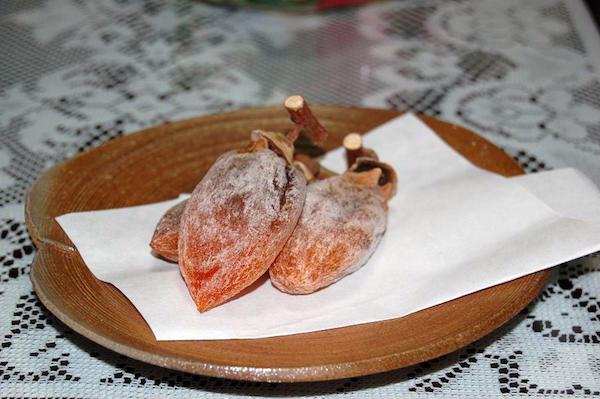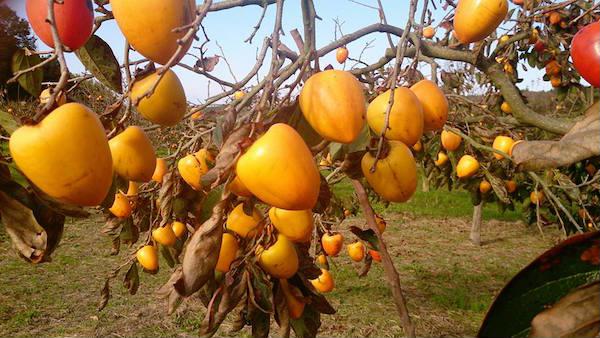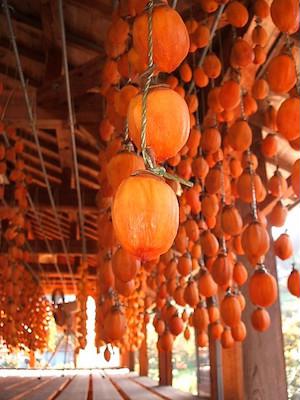Amongst the mountains in Higashiizumo, Shimane Prefecture, there lies a small farming village.
Although it is only small with just 22 houses, this quiet area comes to life once every year during the season of dried persimmon.
So what is dried persimmon?
This is a food which is unique to Japan and is made by drying astringent persimmons.
This gets rid of their juices and turns the fruit into a preserved food.
The astringent juices of the persimmon are actually tannin,
but during the drying process, the tannin reacts with the formaldehyde that is contained in the fruit resulting in a loss of astringency.
Astringent persimmons are generally sweeter than normal ones, and even if you were to dry out the normal ones they would not be as sweet.
It is also worth mentioning that the white powder on the surface of the fruit is safe to eat, it is just dried sugar from the fruit.
The busy autumn of the Dried Persimmon
Village
This farming village has an altitude of around 150 – 200m and lies amongst the mountains with a rough terrain.
The village has a total of 22 houses, 19 of which produce dried persimmons as well as rice.
Here they use the Saijo persimmon, a variety which is native to the areas surrounding Hiroshima.
They measure around 12 – 13cm and are a slightly larger astringent persimmon.
They can be harvested from end of October every year, and after this, the farmers enter into a battle against time for 1 month straight.
One after the other, the persimmons need to be harvested before they ripen and they then need to be dried.
(By the way, fully ripened Saijo persimmons lose their tannin and become extremely sweet. The taste of pure bliss.)
I also visited here once as a TV crew, and if I remember correctly, they begin work at 6am and carry on until 8pm.
Carefully but quickly, one by one
The fruit is harvested by hand and the stem is cut from the tree in a T-shape using scissors, meaning the branch that the fruit is on will fall.
By doing this, the T-shape part of the stem makes it easier to attach the fruit to a piece of string which is used to hang it up to dry.
After they have been cut down, the fruits are taken to the dried persimmon huts.
Here, the area around the hard stem is cut using a machine and the skin is manually peeled from the persimmons.
Everyone works so fast.
Because the persimmons are heavy, it is usually the men who harvest and carry them to the huts while the women do the peeling,
but everyone does what they can.
It takes just 10 seconds to peel a persimmon.
Amber colored curtains shine in the sunlight
After the skin has been peeled, the drying process begins.
The dried persimmon hut is two stories high and the persimmons are dried on the second floor.
The glass windows on this floor cover the entire wall and can be fully opened.
The windows are left open on clear days so that the sun and wind can dry the fruit,
but on rainy days they are closed and a fire is lit inside the hut.
On sunny days, the view of the dried persimmon hut is truly beautiful.
The persimmons that bathe in the sunshine glow a bright orange, but as the drying process advances, this changes into a deep amber.
As autumn progresses and winter draws closer, shipments of dried persimmons begin and the number of dried persimmon huts decrease.
So, if you want to see lots of these huts with dried persimmons hanging down from them,
the best time to visit is from the start to the middle of November.
One bunch contains 10 persimmons, and there are a total of 20 to 30 thousand dried persimmons completely covering one hut.
This is a true masterpiece.
Things to remember when visiting
All of the farmers here are friendly, so if you ask, I am sure they will let you take photos of them while they work or of the inside of the huts.
However, all of the persimmon are valuable food goods so please do not touch them and please do not disturb the farmer’s work.
Also, there are no public car parks within the village and the roads are very narrow, with farming vehicles often passing through them.
On a hill at the far side of the village is the Izumo Kotohira-gu Shrine, which has room for up to 15 vehicles.
Please park here and walk into the village.
The walk from there is downhill, so I think this is an easy place to park.
Dried persimmons are ready to eat from December
Dried persimmons begin to sale in shop in December every year.
If you visit during this period, you should definitely buy some as a souvenir.
With a sweet, vanilla-like fragrance and a sticky texture, they taste nothing like other dried fruit.
They are also available to purchase at the Shimane Prefecture’s Agricultural Society (1635-2 Nishikawatsucho, Matsue, Shimane Prefecture).
One dried persimmon costs around 300 yen, though this varies depending on the size.
They are a little expensive, but they are definitely worth it.
 JAPAN Travel Concierge
JAPAN Travel Concierge

